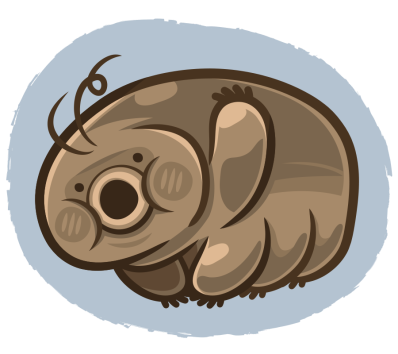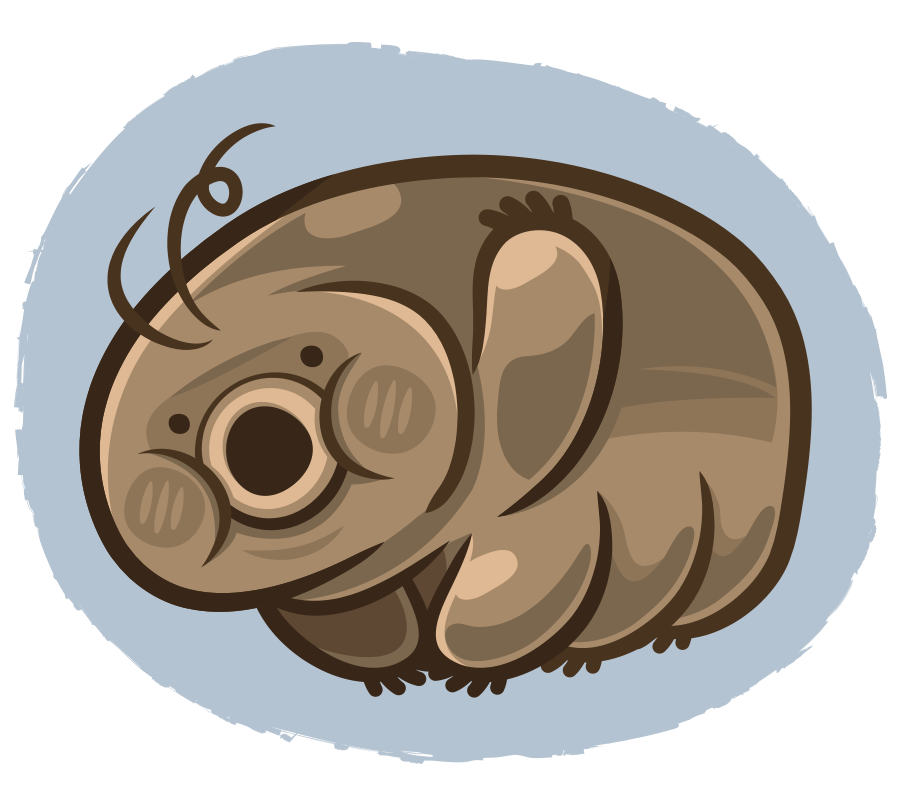Science fiction and superhero stories are filled with people who have extraordinary abilities. People who can heal, who can walk through walls, survive vacuums, see perfectly in the dark. It’s quite a glamorous affair, especially when the characters jump off the page and onto the silver screen.
There are real animals on Earth, though, that do possess superpower-like qualities, many of which are specialized traits that have evolved as survival mechanisms. This post will delve into just one such creature: the tardigrade.

The tardigrade is a microscopic aquatic invertebrate with four pairs of stubby legs. First discovered in 1773 by German zoologist Goeze, over 900 species have since been discovered around the world, and it seems only recently have researchers begun to decipher the molecular mechanisms that allow for this “extremophile” to survive the harshest of environments.
Now, admittedly, the tardigrade is not a glamorous creature, and certainly does not possess the charm and allure of Hugh Jackman as Wolverine—but they’re able to spring back to life just as seemingly effortlessly as he can. Except, instead of evading death by healing, they take a different approach—they become lifeless (termed cryptobiosis, literally meaning “hidden life”).

If that sounds like a contradiction, you’re right. On the surface, avoiding death by essentially dying doesn’t seem like the smartest approach. But here’s the thing—in such a state, they are basically indestructible. They can survive vacuums, extreme temperatures (from -273 to nearly 100°C [that’s -459.4 to 212°F]), high levels of radiation, high pressures, immersion in organic solvents, and even direct exposure to open space (Hashimoto, 2016).
When tardigrades encounter such hostile environments, they shrivel up, dehydrating themselves into an anhydrobiotic body, which is a reversible ametabolic state, known as a “tun.” The tardigrade then replaces the lost water with a sugar called trehalose, which protects biomolecules from dehydration stress. This trait is not limited to tardigrades—many invertebrates (such as rotifers and nematodes) employ tactics like this to avoid desiccation, and the levels of trehalose used between species can vary (Hengherr, 2007). To reverse this state? Just add water.

Protection from these extreme conditions can also be partially attributed to highly specialized and proprietary proteins encoded in the tardigrade’s genome. Whereas most other animals possess only a few stress-response proteins that protect against oxidative damage and repair DNA breaks, the tardigrade has accumulated a veritable library of such genes (Hashimoto, 2016). This considerable expansion helps explain why the tardigrade is so resistant to DNA damage—traits which can be imported into your character.
The process by which the tardigrade acquired these extreme-tolerant genes is currently contested by the scientific community—horizontal gene transfer (HGT) from other species has been floated as a possibility, but it appears that this hypothesis has since been under fire with the argument that genes originally thought to be part of the tardigrade genome were actually misidentified DNA from microbiological contamination (Koutsovoulos G, 2016). Then, there are studies that equivocate a little more, saying that while HGT is responsible for part of the tardigrade’s genome, it is not extensive enough to explain how some species of tardigrades are more resilient than others (Hashimoto T, 2016).
At this point, you might be thinking “okay, that’s all fascinating and everything, but how can all this be applied to characters in my science fiction novel?”

In fact, it is actually not such a far-fetched idea for a sci-fi character to acquire these traits. The genes encoding some of these proteins (Damage suppressor [Dsup], in particular, a gene unique to the tardigrade) have been transferred to human cells in in vitro cultures, which resulted in enhanced radiotolerance of the human cells (Hashimoto T, 2016; Hashimoto T, 2017). This particular protein works by associating with DNA, acting as a sort of protein shield against radioactive damage.
In a fictional world where science has presumably accelerated past what we have today, it might be plausible to extrapolate the findings in the above study to include many other proteins that may promote survival to a variety of elements, rather than just the one gene. This, in summary, may be able to confer resistance to extreme cold, heat, dehydration and radiation.
Possessing these traits, however, may make your character seem indestructible—but in fact, even with these advantages, the tardigrade does have weaknesses, which you can also exploit and expand upon for your character. For example, their ability to withstand exposure to space is limited, and despite their hardiness, they are not long-lived when not in cryptobiosis (though the cryptobiotic state is a little like hitting the pause button on these little guys).
It’s also important to note that if the tardigrade is exposed to pure water (as opposed to seawater), it will swell and become unable to contract its muscles. This renders it incapable of tun formation, and upon dehydration, the tardigrade will collapse rather than curl up (Hygum, 2016). In Hygum’s experiment, tardigrades could still recover from dehydration after pure water exposure, but took significantly longer to do so compared to the seawater group. This, in a work of fiction, could potentially translate into a specific item or quality of item needed to ‘reanimate’ a character—alternatively, such a relatively common resource as fresh water could also serve to disable the characters’ protection or have them take longer to recover after exposure to harmful conditions.

It’s also important to remember that while the hardiest tardigrade species can survive such environments with tun formation, they may be able to do little else in this state because they have not adapted to live in these conditions. When developing your character’s skill set, it will be important to remember that these traits are for defense only, so if you want offensive skills for your character, you will have to rely on another explanation.
Lastly, the tardigrade’s hardiness should not be mistaken for complete invulnerability either—i.e., a paper cut still won’t magically seal itself shut without a non-tardigrade explanation. In other words, while your character may be able to survive in the extreme cold and vacuum of space without the burden of proper gear, they will still die if an asteroid hits them.

Alright, everyone, that about concludes this post about the tardigrade. I’ve glossed over many things, but provided links to multiple papers about this remarkable animal in case anyone is so inclined to delve deeper into this creature.
Though, I will leave you with one extra little note: in addition to all of the above, it’s also nicknamed the “water bear” (for their bear-like gait) or the “moss piglet” (for their algae-based diet).

Thank you for reading, and I hope this was helpful. If you have any questions, or found mistakes, or would like to see another animal showcased in a future post, please leave your thoughts as a comment below!
Til next time!



This is such fascinating information for writers looking for new sci-fi ideas! Awesome job with the research and sharing it with everyone.
LikeLiked by 1 person
Thank you! Happy you found this post interesting 🙂
LikeLiked by 1 person
Reblogged this on The Philosopher-Scientist and commented:
Read this amazing post about the superpowers of tardigrades, or water bears!
LikeLiked by 1 person